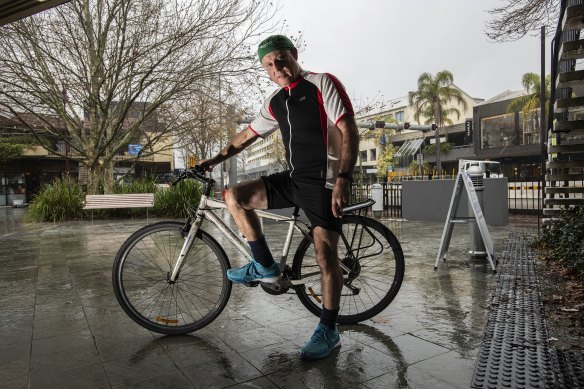- Exclusive
- National
- Healthcare
How Tom walked away from knee pain without expensive surgery
By Kate Aubusson and Liam Mannix
Orthopaedic surgeon Christopher Vertullo finds himself regularly talking patients out of having surgery.
Roughly one in three people walk into his practice bracing for a grim prognosis: major surgery, thousands of dollars and weeks of recovery, only to be told that they have osteoarthritis and the best thing to do is get moving.

Tom Buttel was 28 when his surgeon told him he had the knee of an 80-year-old.Credit: Steven Siewert
“They are in total shock,” Vertullo said. “I’d say roughly 60 per cent of patients would have spent thousands of dollars on investigations like MRIs or CT scans that they don’t need before they get to me.”
There has been an explosion in the number of Australians with osteoarthritis of the knee undergoing unnecessary imaging and avoidable knee replacements, which is set to worsen thanks to our ageing population and growing obesity rates.
New clinical guidelines aim to reverse the trend, advising clinicians and patients to nix surgery in favour of regular exercise and weight management to ease their pain and improve mobility.
The revised 2024 Osteoarthritis of the Knee Clinical Care Standard, released on Thursday by the Australian Commission on Safety and Quality in Health Care (ACSQHC), debunks the myth that knee surgery is the silver bullet.
Medical adviser for the commission and GP Dr Phoebe Holdenson Kimura said robust new research has transformed our knowledge of the knee joint and soft tissues.
“[Many] people living with osteoarthritis think it’s just a condition that gets worse over time, and you just have to bear it until you get to the stage where you need a knee replacement,” Holdenson Kimura said.
“What we’re trying to help people understand [is you] can often avoid surgery with all its associated costs and risks.”
Osteoarthritis of the knee affects more than 1.2 million Australians, the vast majority aged over 45. Every year, more than 53,500 knee replacements are performed to treat knee osteoarthritis in Australia. By 2030, these surgeries are expected to increase by 276 per cent.
Key changes in the clinical standard for osteoarthritis of the knee
- Imaging should not be routinely used. X-ray is the first preference if imaging is warranted
- Focus on non-surgical interventions such as exercise and weight management
- Use language that is positive and avoid unhelpful beliefs and unnecessary concerns
- Avoid opioids, some joint injections and other medicines
A new key recommendation is to avoid imaging. Doctors can confidently diagnose knee osteoarthritis without them, but they often trigger unhelpful worry that can snowball into interventions that don’t treat the pain.
“MRIs are particularly bad for this,” Holdenson Kimura said. “It’s hard not to look [at the results] and think ‘oh gosh, my knee is stuffed’.”

Orthopaedic surgeon Christopher Vertullo.
Patients see the imaging results referencing alarming descriptions of meniscus tears and chondral thinning, when really the source of their pain is osteoarthritis, said Vertullo, adjunct professor, Deputy Clinical Director of the Australian Orthopeadic Association National Joint Replacement Registry and one of the experts involved in updated the guidelines.
Holdenson Kimura said research shows that imaging findings don’t correlate with a person’s symptoms.
“We need to treat the person, not the scan,” she said.
The updated guidelines also advise clinicians to avoid using negative language that catastrophises osteoarthritis.
“Phrases like ‘bone on bone’ and ‘wear and tear’ suggest we will damage our joints by moving them, which is simply not true,” Holdenson Kimura said.
“It also involves inflammation, injury, trauma to the knee. It’s a much more complex condition than we had thought in the past.”
‘Phrases like ‘bone on bone’ and ‘wear and tear’ suggest we will damage our joints by moving them, which is simply not true.’
GP Dr Phoebe Holdenson Kimura
Tom Buttel was 16 years old when he blew out his knee playing rugby. At 28, his surgeon told him he had the knee of an 80-year-old.
“He told me, ‘Tom it’s time to hang up the boots, mate’,” Buttel said. “He said I needed a knee replacement, but he wouldn’t consider doing it until I turned 50.”
Instead of waiting, Buttel joined a study that got him into the gym.
“I did an hour in the gym, and an hour in the pool. I saw a physio, an exercise physiologist, and a rheumatologist. I started to educate myself and I realised that exercise and losing weight are the things to do,” he said.
Now 64, Buttel cycles, goes on long walks and takes the stairs every chance he gets.
“My knee is better now than when I was playing rugby ... and as long as it stays as it is now, I don’t think I’ll need a knee replacement,” Buttel said.
Holdenson Kimura said the advice may sound counterintuitive.
“People are worried about damaging their knee further by exercising, but the research shows that knee joints are strong, healthy and designed to be loaded even when you have some degeneration,” she said.
“It is safe to be active, even if it’s a bit sore at the start.”
Vertullo said knee replacements are life-changing for people with severe end-stage osteoarthritis.
“A patient should only be considered for joint replacement once they have maximised non-operative management as much as possible, and reached a point where their pain is untenable or unmanageable,” he said.
Start the day with a summary of the day’s most important and interesting stories, analysis and insights. Sign up for our Morning Edition newsletter.